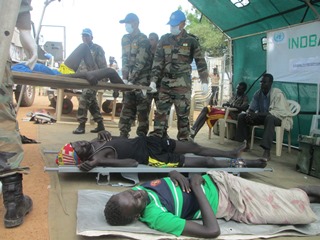Jonglei’s Bor hospital treats 279 wounded in local clashes
July 20, 2013 (BOR) – The number of patients received by Jonglei’s Bor hospital through the South Sudan Red Cross (SSRC) has now reached 279, with more than 50 others still to be evacuated to the capital on Sunday.

He said seven of the cases needed immediate surgical treatment.
Gai also expressed concern about the long distances the patients walked to reach Manybol, adding that many of those with gunshot wounds died before reaching the town.
“We are a bit worried this time, because the patients are coming from far places. They walked two days or more to reach Manybol of which those who were shot in the chest died on the way. We did not receive patients with bone fractures for the last two days because of the distances they walked”, he explained.
Ethnic violence between the Lou Nuer and Murle tribal groups again erupted in Jonglei state during the first week of July, when thousands of armed Lou Nuer men travelling on foot moved into remote areas of Jonglei’s Pibor county, an ethnic Murle area.
There are unconfirmed reports that the SPLA supported Lou Nuer groups with weapons and other supplies, including food and water.
According to the UN Office for the Coordination of Humanitarian Affairs (OCHA), all six of Pibor’s major population centres have since been abandoned, with about 40,000 inhabitants displaced. At least 8,500 Murle are estimated to have fled to neighbouring countries this year, while about 7,000 escaped to the South Sudanese capital, Juba.

Two days ago, the youth leader of the Murle tribe, Paul Kuakuak complained to rescue agencies about delays in bringing Murle patients for treatment.
Gai said SPLA and UN troops on the ground in Manybol and Pibor did not generally go in search of patients in the bush, but instead provided assistance to those who came to their camps seeking treatment.
According to Gai, whose team is deployed in Bor, local hospitals were so far only receiving patients brought by either UN or SPLA helicopters.
It remains unclear how much ground the Lou Nuer have gained after Manybol since they started their attacks in Pibor on 6 July.
Gai has also confirmed that 40 children are among the patients received at Bor hospital. Their ages range from 15-17 and all are from the Lou Nuer tribal group.
However, he said medical teams in Bor had yet to receive any patients from the Murle side since fighting began, stressing that it was not the SSRC’s policy to segregate patients.
“Wounded are wounded, they are equal before us, regardless of their tribes”, he said. “Up to now, there is not any person from that side [Murle side], we don’t even ask our patients about their sides, that is not our interest”, he added.
(ST)
